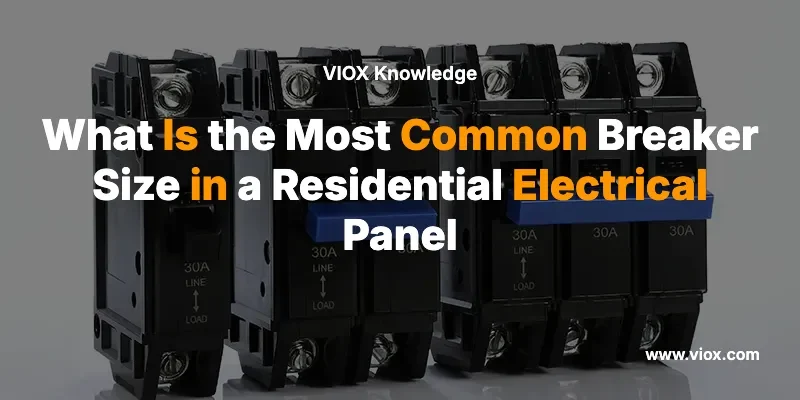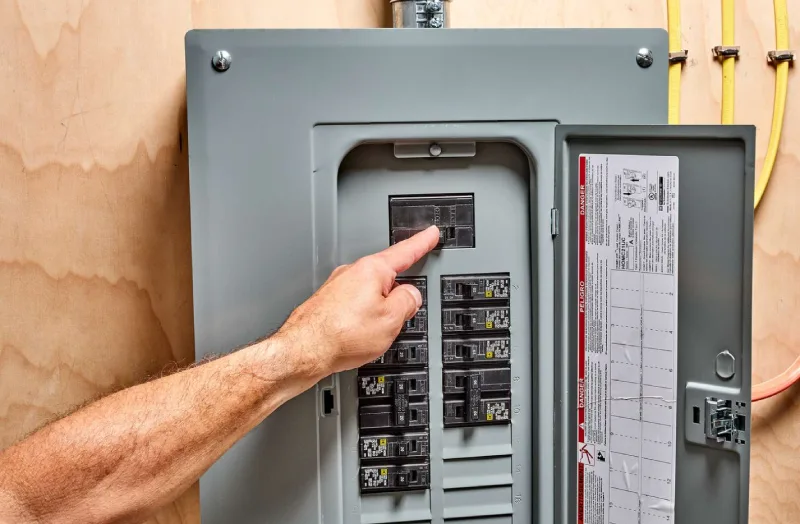迅速に回答: 住宅用電気パネルで最も一般的なブレーカーのサイズは 15アンペア20アンペアのブレーカーがそれに続きます。これらの2つのサイズは、標準的な家庭用電気パネルの全ブレーカーの60~70%を占め、15アンペアのブレーカーは一般的な照明回路を保護し、 20アンペア キッチンのコンセント、バスルーム、その他の需要の高いエリアに電力を供給するブレーカー。
住宅用ブレーカーの基礎を理解する
サーキットブレーカー ブレーカーは、ご家庭の電気システムにおける重要な安全装置として機能し、回路が過負荷になると自動的に電力を遮断します。ブレーカーのサイズを理解することで、住宅所有者は電気設備のアップグレード、トラブルシューティング、安全基準遵守について十分な情報に基づいた判断を下すことができます。
ブレーカーのサイズが家の安全にとって重要な理由
回路ブレーカーのアンペア定格は、ブレーカーがトリップするまでに回路を安全に流せる電流量を決定します。不適切なサイズのブレーカーを使用すると、次のような問題が発生する可能性があります。
- 火災の危険性 過負荷回路から
- 機器の損傷 電力供給不足から
- コード違反 住宅検査中
- 保険金請求の拒否 電気事故の後
標準的な住宅用ブレーカーサイズの完全な内訳
15アンペアのブレーカー:最も一般的な選択肢
使用率: 住宅用ブレーカー35-40%
主な用途:
- 家全体の一般的な照明回路
- 寝室のコンセント(AFCIエリア以外)
- リビングルームの標準コンセント
- 廊下とクローゼットの照明
必要なワイヤゲージ: 14 AWG銅線
最大安全荷重: 12アンペア(定格容量80%)
専門家にヒント: 15 アンペアのブレーカーは 15 アンペアを処理できますが、米国電気工事規程 (NEC) では、連続負荷がブレーカー定格の 80%、または 15 アンペアの回路の場合は 12 アンペアを超えないようにすることが推奨されています。
20アンペアのブレーカー:多用途の働き者
使用率: 住宅用ブレーカー25-30%
主な用途:
- キッチンカウンターコンセント(GFCI保護)
- バスルームのコンセントと照明
- ランドリールームの回路
- ガレージアウトレット
- 屋外コンセント(GFCI保護)
必要なワイヤゲージ: 12 AWG銅線
最大安全荷重: 16アンペア(定格容量80%)
高アンペアブレーカー:特殊用途
| ブレーカーサイズ | パネルの割合 | 一般的なアプリケーション | ワイヤゲージ |
|---|---|---|---|
| 30アンペア | 10-15% | 電気乾燥機、給湯器 | 10AWG |
| 40アンペア | 5-8% | 電気レンジ、大型エアコン | 8AWG |
| 50アンペア | 3-5% | 電気レンジ、RV用コンセント | 6AWG |
| 60アンペア以上 | 2-3% | ホットタブ、電気自動車充電器 | 4 AWG以上 |
砕波の大きさの分布における地域差
現代の建設トレンド(2020~2025年)
最近の建築基準法とライフスタイルの変化により、ブレーカーのサイズの好みは変化しました。
- 20 アンペアの回路を増加: 現代の住宅では、機器の負荷増加に対応するため、20アンペアの回路が通常より多く設置されている。
- AFCI 要件: アーク故障遮断器は、現在、ほとんどの15アンペアおよび20アンペアの寝室の回路に必須となっています。
- EV準備: 新築物件では40~50アンペアのEV充電回路が備えられていることが多い
古い住宅に関する考慮事項(1990年以前)
1990 年以前に建てられた住宅では分配が異なる場合があります。
- 15 アンペアの回路の割合が高い: 古い家は15アンペアの回路に大きく依存していた
- キッチン回路の減少: 古いキッチンでは、現代の電化製品には20アンペアの回路が足りない場合があります。
- パネルのアップグレードの要件: 多くの古いパネルは、現在の電力需要を満たすために更新が必要です
パネルのブレーカーサイズを決定する方法
ステップバイステップの識別プロセス
- 電気パネルの位置を確認する (通常は地下室、ガレージ、またはユーティリティルーム)
- パネルカバーを開く 慎重に(不明な場合はメインブレーカーをオフにしてください)
- ブレーカーのラベルを読む – アンペア数は各ブレーカーハンドルに印刷されています
- 在庫を作成する 各ブレーカーのサイズと保護回路をリストします
- 回路の目的を確認する パネルスケジュールを使用する(利用可能な場合)
パネルを検査する際の安全上の注意事項
- 露出した電線には絶対に触れないでください またはパネル内の金属部品
- 懐中電灯を使う 検査時に頭上の照明ではなく
- 患部を乾燥した状態に保つ – 濡れた手や湿った状態でパネルを検査しないでください
- 専門家に電話する 焦げた臭い、腐食、または部品の損傷に気付いた場合
電気パネルブレーカーをアップグレードするタイミング
専門家による評価が必要な兆候
直ちに注意すべき危険信号:
- 明らかな原因もなくブレーカーが頻繁に落ちる
- 電気パネルから焦げた臭いがする
- 大型家電の電源を入れると照明が暗くなる
- 温かいまたは熱いブレーカーハンドル
- ブレーカーの目に見える腐食または損傷
容量アップグレード指標:
- 需要の高い新しい家電製品(エアコン、電気自動車)の追加
- 追加の回路を必要とするキッチンやバスルームの改装
- 電気設備の拡張を必要とする住宅の増築
- ガスから電気への切り替え
プロ vs. DIY の考慮事項
以下の場合は必ず資格を持った電気技師を雇ってください。
- 新しいブレーカーや回路の設置
- アップグレード パネル 容量
- メインブレーカーに関わる作業
- 電気の問題のトラブルシューティング
住宅所有者向けの作業:
- 既存の回路の識別とラベル付け
- 落ちたブレーカーをリセットする
- 基本的な電気負荷計算
- 請負業者に相談する前に電気設備のアップグレードを計画する
ブレーカーの交換とアップグレードにかかるコストの検討
典型的な 交換 コスト(2025年の価格)
| サービスタイプ | コストの範囲 | 価格に影響を与える要因 |
|---|---|---|
| シングルブレーカーの交換 | $150-$300 | ブレーカーの種類、アクセス性、地域料金 |
| 複数のブレーカーのアップグレード | $500-$1,200 | 回路数、配線交換の必要性 |
| パネル容量のアップグレード | $1,500-$4,000 | 現在のパネルの状態、電気サービスサイズ |
| パネルの完全交換 | $2,000-$6,000 | 住宅の大きさ、複雑さ、地域の許可費用 |
プロジェクトコストを増加させる要因
- 古い家の配線: 新しい回路による大規模な配線変更が必要になる場合があります
- コードコンプライアンスの更新: 古い設備を現在のNEC基準に適合させる
- 許可要件: 自治体の許可と検査は時間とコストを増加させる
- アクセスの課題: 届きにくいパネルは人件費を増大させる
住宅用ブレーカーのサイズに関するよくある質問
15 アンペアのブレーカーを 20 アンペアのブレーカーに交換できますか?
いいえ、これは危険であり、規則違反です。 ブレーカーのサイズは、回路内の電線サイズと一致する必要があります。小さい電線に大きいブレーカーを取り付けると、ブレーカーが作動する前に電線が過熱し、火災の危険が生じます。
一部の回路では 20 アンペアではなく 15 アンペアのブレーカーが使用されるのはなぜですか?
コストと必要性。 15アンペアの回路と14 AWG 12AWGの電線を必要とする20アンペアの回路よりも、15アンペアの電線の方が設置コストが低くなります。照明や需要の少ないコンセントの回路では、15アンペアで十分な容量を確保しながら、設置コストを削減できます。
15 アンペアの回路にはコンセントがいくつありますか?
通常8~10店舗、 しかし、実際の制限はコンセントの数ではなく、予想される電気負荷によって決まります。寝室では15アンペアの回路で10個のコンセントが安全に使用できるかもしれませんが、ホームオフィスではコンピューター機器があるため、最大6個のコンセントが限界となる場合があります。
新しい住宅ではブレーカーのサイズ分布が異なりますか?
はい、かなり。 2010 年以降に建てられた住宅では、現代のデバイスや家電製品による電気需要の増加、およびキッチンやバスルームの回路に対するコード要件により、通常、20 アンペアの回路が多くなっています。
単極ブレーカーと双極ブレーカーの違いは何ですか?
電圧と用途。 単極ブレーカー(15、20、30 アンペア)は 120V 回路に使用され、双極ブレーカー(通常 30 アンペア以上)は乾燥機、レンジ、エアコンなどの大型家電製品の 240V 回路に使用されます。
電気の未来を計画する:スマートブレーカー戦略
現代の電気需要への備え
今日の住宅は、これまで以上に多くの電力を必要としています。電気設備のアップグレードを計画する際には、以下のトレンドを考慮してください。
- スマートホーム統合:
- デバイス充電ステーション用の追加20アンペア回路
- スマートホームハブおよびネットワーク機器用の専用回路
- スマートスイッチと調光器用の照明回路のアップグレード
- 電気自動車の準備:
- レベル2 EV充電用の40~50アンペアの回路
- 追加の負荷に対応できるようにメインパネルの容量をアップグレード
- 複数のEV充電ステーションの将来性
- エネルギー効率のアップグレード:
- 30~60アンペアの回路を必要とするヒートポンプシステム
- 太陽光パネルのインバータ回路(通常30~50アンペア)
- 専用の高アンペア回路を必要とするバッテリーバックアップシステム
結論:情報に基づいた電気パネルの決定
住宅の電気パネルの大部分が15アンペアと20アンペアのブレーカーで構成されていることを理解しておくと、住宅所有者は電気システムについて十分な情報に基づいた決定を下すことができます。一般的な照明やコンセントの回路では15アンペアのブレーカーが依然として最も一般的ですが、20アンペアの回路へのトレンドは、現代の住宅における電力需要の増加を反映しています。






